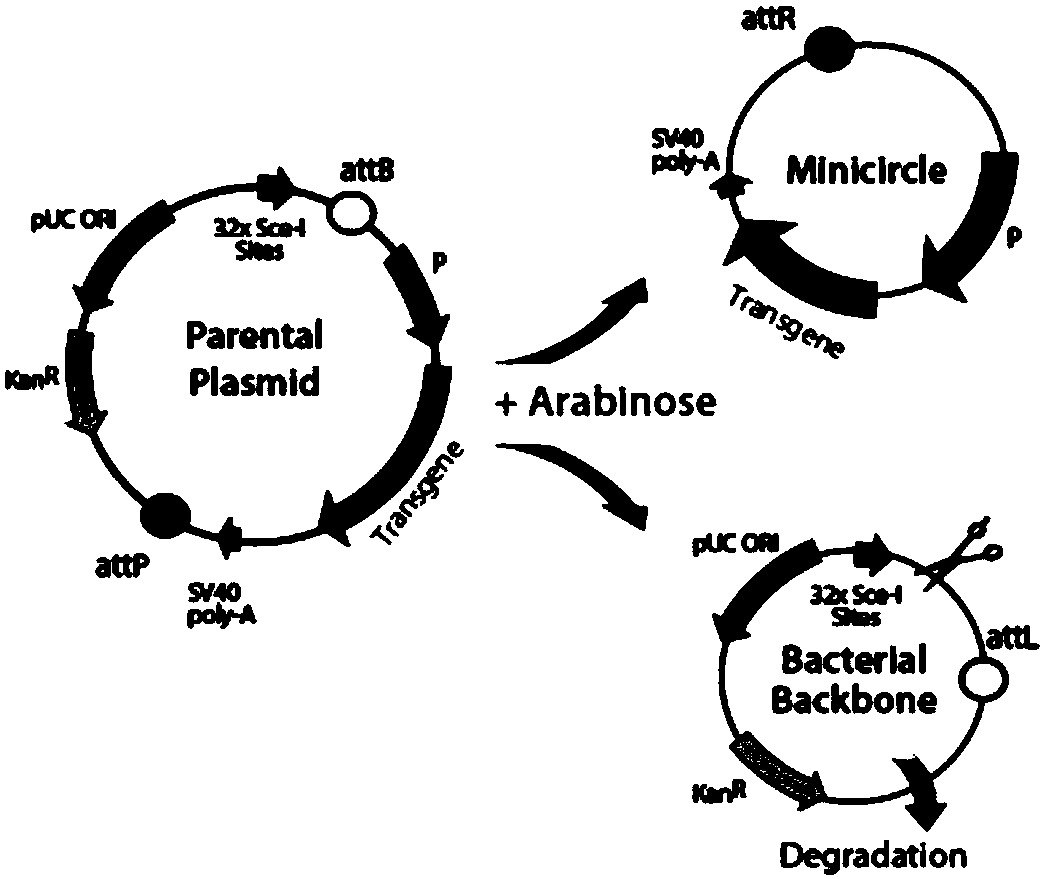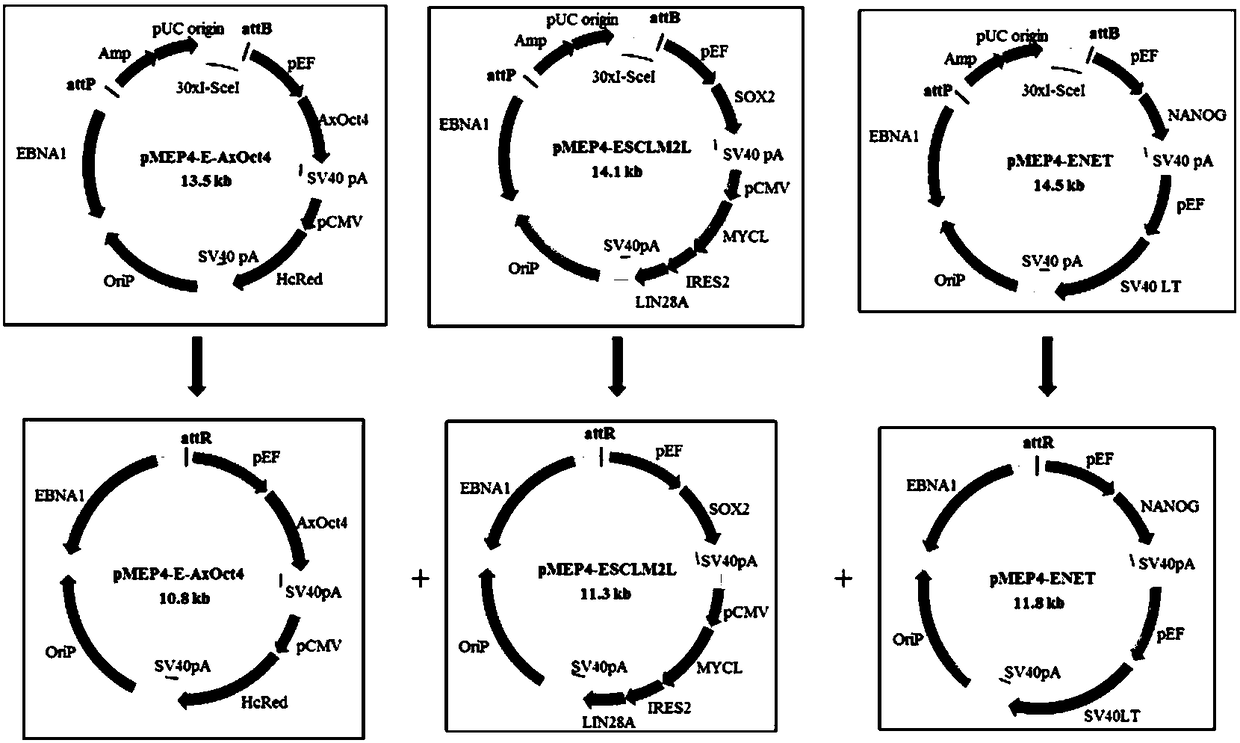Method of using annulet free carrier to efficiently reprogramming blood cells to generate iPSC
A technology of dissociated vectors and blood cells, which is applied in the field of efficient reprogramming of blood cells to generate iPSCs with microcircular dissociated vectors, which can solve problems such as increased safety hazards, abnormal karyotype, and low reprogramming efficiency, and achieve high transfection efficiency Effect
- Summary
- Abstract
- Description
- Claims
- Application Information
AI Technical Summary
Problems solved by technology
Method used
Image
Examples
Embodiment 1
[0070] Example 1 The construction idea of minicircle DNA parental plasmid
[0071] The microcircle DNA parental plasmid construction strategy of the present invention is shown in the figure figure 1 shown. The attB in the microcircle DNA parent plasmid in the figure is the bacterial attachment site of recombinase Ф31; attP is the phage attachment site; 32×Sce-I sites contain 32 consecutive I-SceI restriction enzyme sites; pUC ORI plasmid replication origin; Kan R kanamycin resistance gene; SV40poly-A is the PolyA tailing signal of Simian vacuolar virus; Transgene indicates the nucleotide sequence of the inserted foreign gene; P is the promoter of the foreign gene expression cassette , generally a conventional promoter, preferably a eukaryotic promoter, more particularly a pEF1α promoter or a CMV promoter. The process of site-specific recombination of the microcircle DNA parent plasmid in the host bacteria is as follows: the microcircle DNA parent plasmid has attB sites and...
Embodiment 2
[0075] Example 2 Construction of pMEP4-E-AxOct4, pMEP4-ESCLM2L and pMEP4-ENET minicircle DNA parental plasmids
[0076] Construct minicircle DNA parental plasmids via the following protocol
[0077] S1. Synthesize an empty minicircle DNA plasmid containing attB, attP, and 30×I-SceI restriction endonuclease cutting site sequences through a commercial company.
[0078] S2, respectively for the attached figure 2 The shown pEP4-E-AxOct4, pEP4-ESCLM2L and pEP4-ENET free-type vectors were double-digested, and the results of the digestion were identified by agarose gel electrophoresis, and nucleotide fragments of different sizes were obtained after digestion.
[0079] S3. Use T4 DNA ligase to insert the obtained nucleotide fragments into the empty minicircle DNA plasmid, perform ligation at 4°C overnight or at room temperature for 1 hour, and then add the ligation product to E.coli DH5α strain to sense Transformation was carried out in the state cell suspension, and inoculated on ...
Embodiment 3
[0081] Example 3 Preparation of pMEP4-E-AxOct4, pMEP4-ESCLM2L and pMEP4-ENET minicircle DNA
[0082] Construct minicircle DNA parental plasmids via the following protocol
[0083] S1. Using the pMEP4-E-AxOct4, pMEP4-ESCLM2L and pMEP4-ENET microcircle DNA parental plasmids constructed in Example 2, transform ZYCY10P3S2T engineering bacteria at 37°C, and culture them statically for 14-16 hours;
[0084] S2. Pick a single clone from the engineered bacteria containing the microcircle DNA parental plasmid obtained in S1 and culture it in suspension overnight; add an equal volume of fresh LB medium containing arabinose after overnight, and the final mass volume concentration of arabinose is 0.1%, that is, Contain 1 g of arabinose in 1 L of aqueous solution, incubate for 4 hours at a temperature of 32 °C and a shaking frequency of 250 times / min to induce ZYCY10P3S2T engineering bacteria to express ФC31 integrase and restriction endonuclease I-SceI;
[0085] S3. Contacting the microc...
PUM
 Login to View More
Login to View More Abstract
Description
Claims
Application Information
 Login to View More
Login to View More - R&D
- Intellectual Property
- Life Sciences
- Materials
- Tech Scout
- Unparalleled Data Quality
- Higher Quality Content
- 60% Fewer Hallucinations
Browse by: Latest US Patents, China's latest patents, Technical Efficacy Thesaurus, Application Domain, Technology Topic, Popular Technical Reports.
© 2025 PatSnap. All rights reserved.Legal|Privacy policy|Modern Slavery Act Transparency Statement|Sitemap|About US| Contact US: help@patsnap.com



